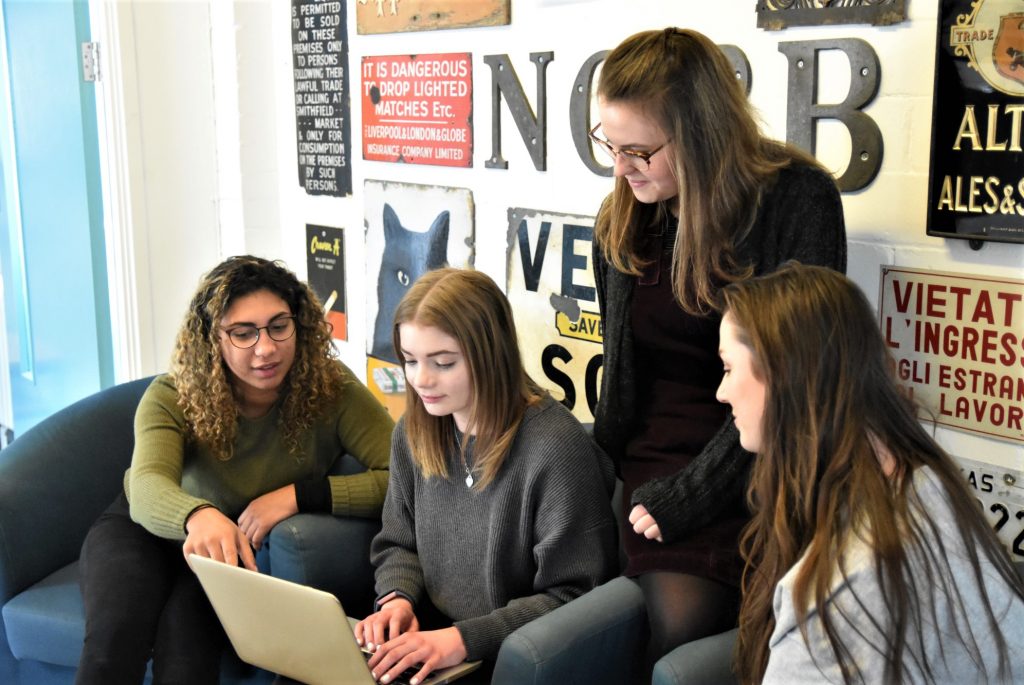Beginning A Room of Our Own: The Virginia Woolf Learning Journals
Madeleine Davies
Following the success of Second Sight, I decided to produce a ‘sequel’ based on my ‘Virginia Woolf & Bloomsbury’ module, using the finest work from two cohorts’ learning journals (2018-19 and 2019-20) so as to spread the opportunity between two years’ worth of students. This time, we had six months to plan and prepare the book.
We began in September 2019. I had already organised funding through the Vice-Chancellor’s Endowment Fund. With this funding, I advertised the ‘Real Job’ and found Katy Smith, a final year undergraduate in the Department of Typography. Her supervisor for the project would be Professor Eric Kindel and Geoff Wyeth would see the book through the production process.
I also identified three final year student editors from the Department of English Literature to help with me with the selection of pieces, design decisions, editing and proofreading, and social media management. Maddie Bazin and Libby Bushill were enrolled on the ‘Virginia Woolf’ module and Zoë Kyle, a gifted writer who was not enrolled on the module, provided a less specialised eye on the writing.
Until January 2020, the editorial group could not begin editing because the journal entries had not been finally assessed until then. In the meantime, we discussed overall design issues and I distributed a form to the Woolf students which gave their permission to have their work included in the book. If they did not want to take part, there was obviously no pressure to do so (that said, the overwhelming majority of students did want to be included). If students submitted their ‘Permissions’ form to me, at least one of their entries would definitely be included in the book.
While we waited for the new material to be written and assessed, we gathered together the previous year’s work and launched an Art competition in the Department of Fine Art to find some illustrations for the book and to find the cover.
The editing process
Producing the collaborative books involves a series of steps to create professional final products of which we can all feel proud.
The first stage is to identify sponsorship: for A Room of One’s Own, I was grateful to receive a sum of money from the Vice-Chancellor’s Endowment Fund to cover the production costs. The second stage is to recruit gifted student editors and designers in a fair, transparent selection process. Initial methodology and design decisions are taken by the group and all the ideas presented are given equal value.
At this early stage, another vital step is to circulate a ‘Release and Publish’ form to students which offers them the chance of having their work presented in the book; by signing the form, the students give their permission to us to edit and use their work. There is obviously no pressure on any student to participate but we find that almost every student welcomes the chance to see their writing in print.
Our process for A Room of Our Own was then as follows: when assessment and marking processes had been completed, I copied from Blackboard the entries of those students who had given us permission to include their work in the book and pasted the individual pieces into a Word document so that students’ feedback and marks would remain completely confidential. I also anonymised the pieces, keeping a named copy of the document for myself. This meant that the student editors could not tell who had written the pieces so they were judging them anonymously. From here, the editors selected the outstanding pieces of writing, keeping an eye on the variety in the book as a whole. Because Maddie and Libby, as members of the Woolf seminar group, could not be expected to select their own work for A Room of Our Own, Zoë and I decided which of their pieces should be included. Only when the final selection was complete did I reveal authors’ names.
Following the final selection, I produced a new Word document including all the pieces to be presented in the book. I removed the pieces we felt didn’t fit and I added authors’ names. This document was sent to the editors.

Editing then began in earnest. Each editor took a section of the book and set about imposing presentational conformity (putting text titles in italics, for example), removing any grammatical errors in the individual pieces, and finding the most powerful order of pieces within their sections. As each editor returned their sections to me, I created the first full draft of the book on a new document. I also began preparing the Bibliography from all the references used in the pieces.
The value of working collaboratively on the books is that everyone’s ideas combine to create a unique whole. For example, Katy’s contribution to one of the key design features of A Room of Our Own, recreating Virginia Woolf’s handwriting, is outlined here.
